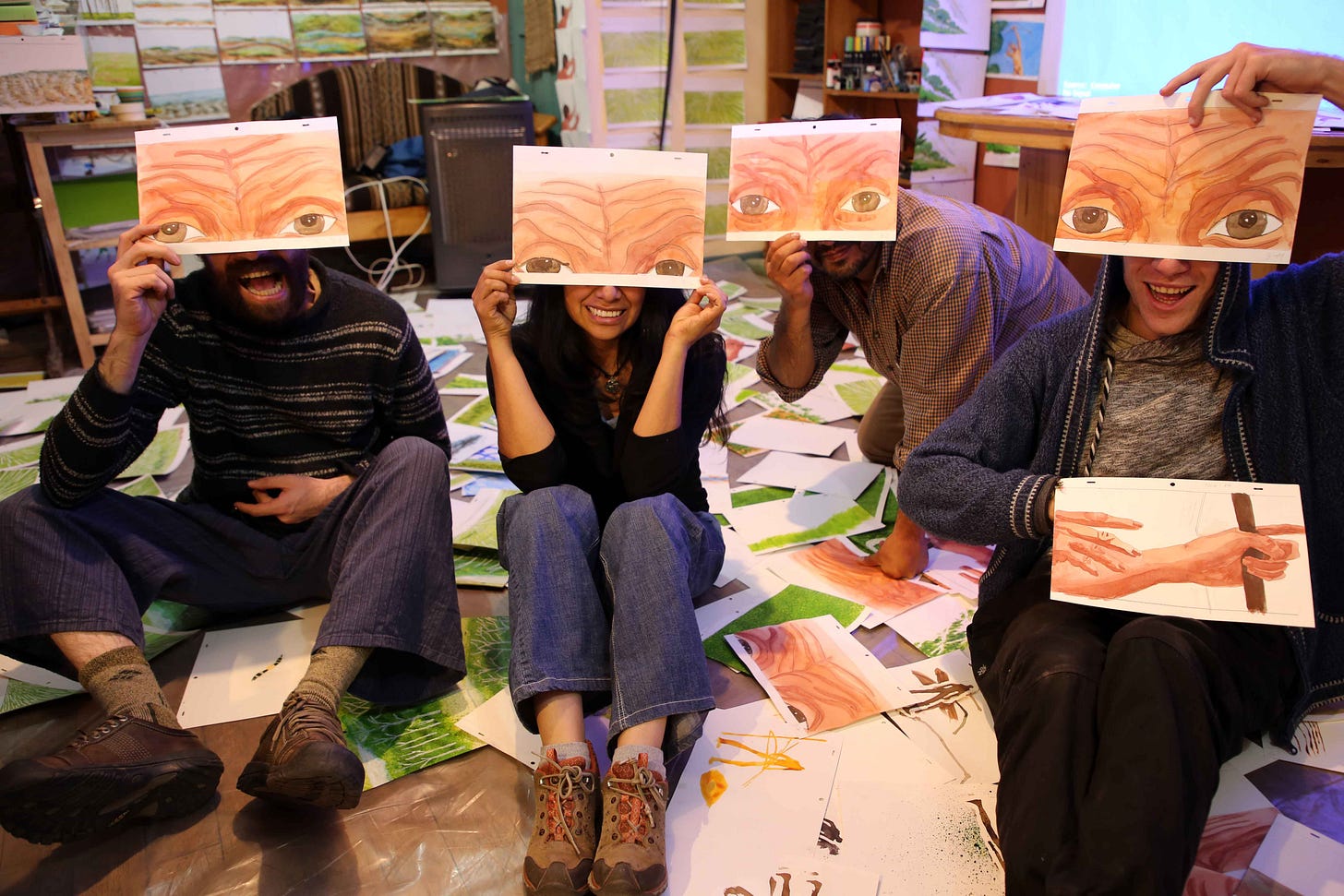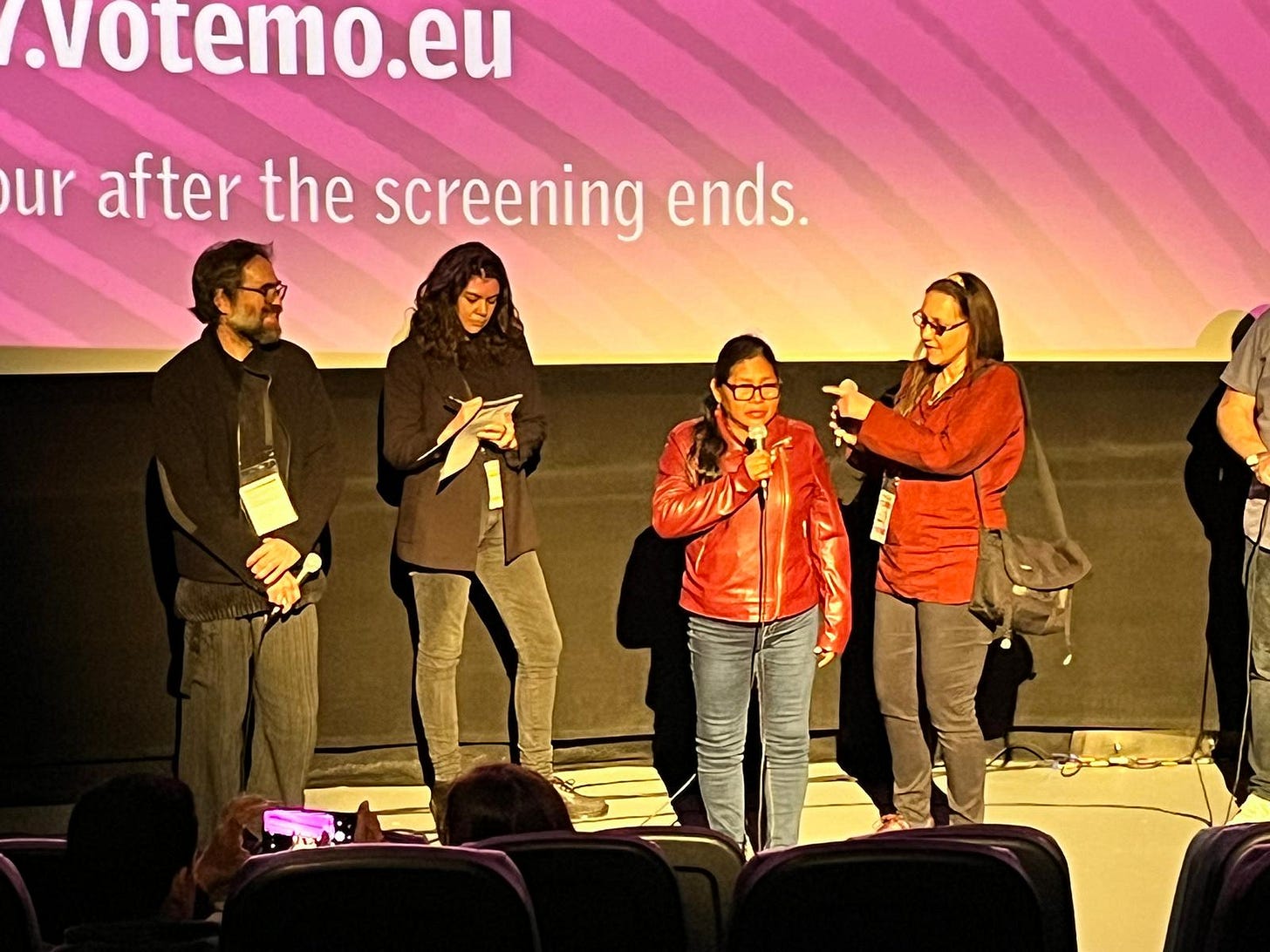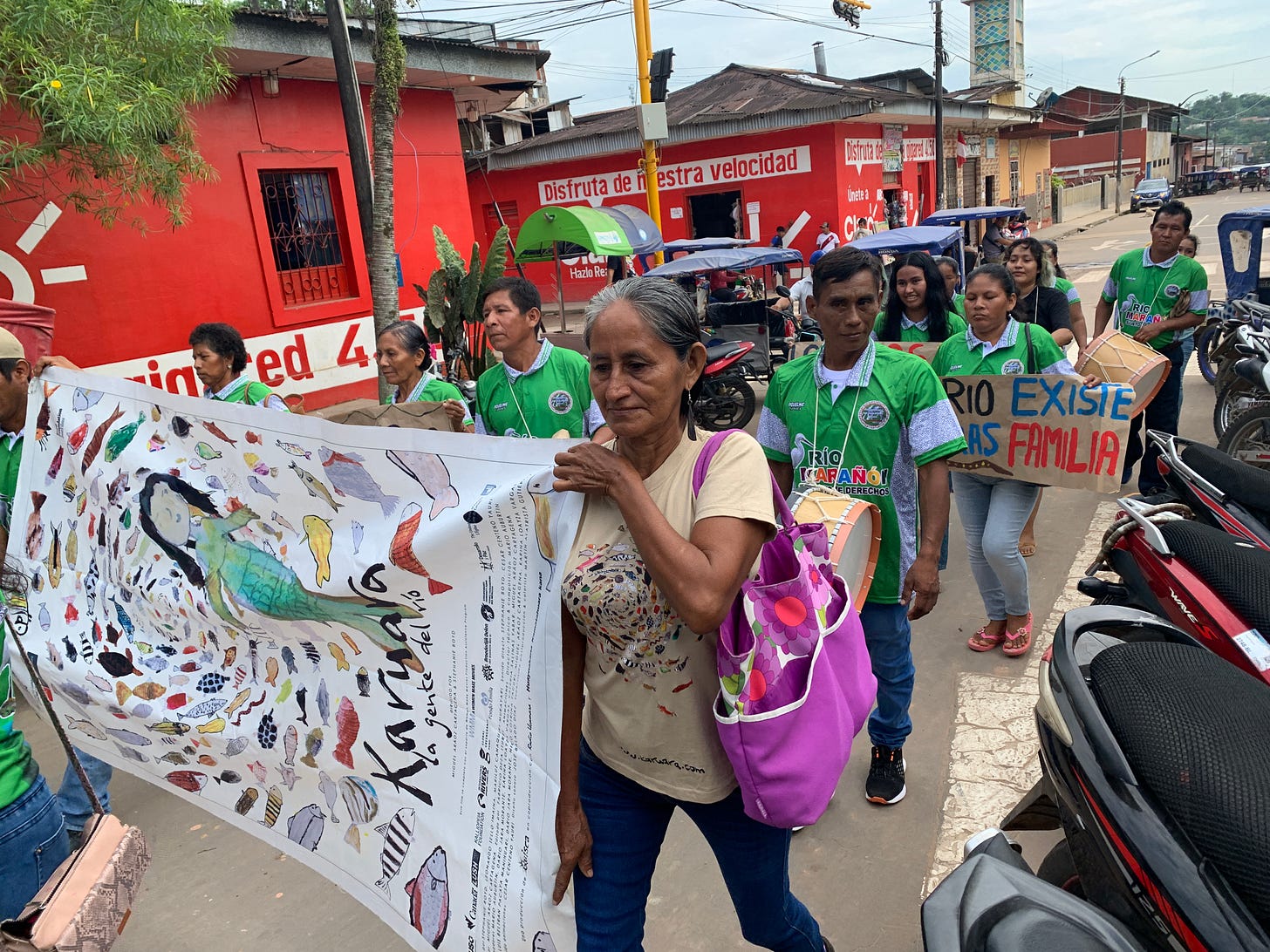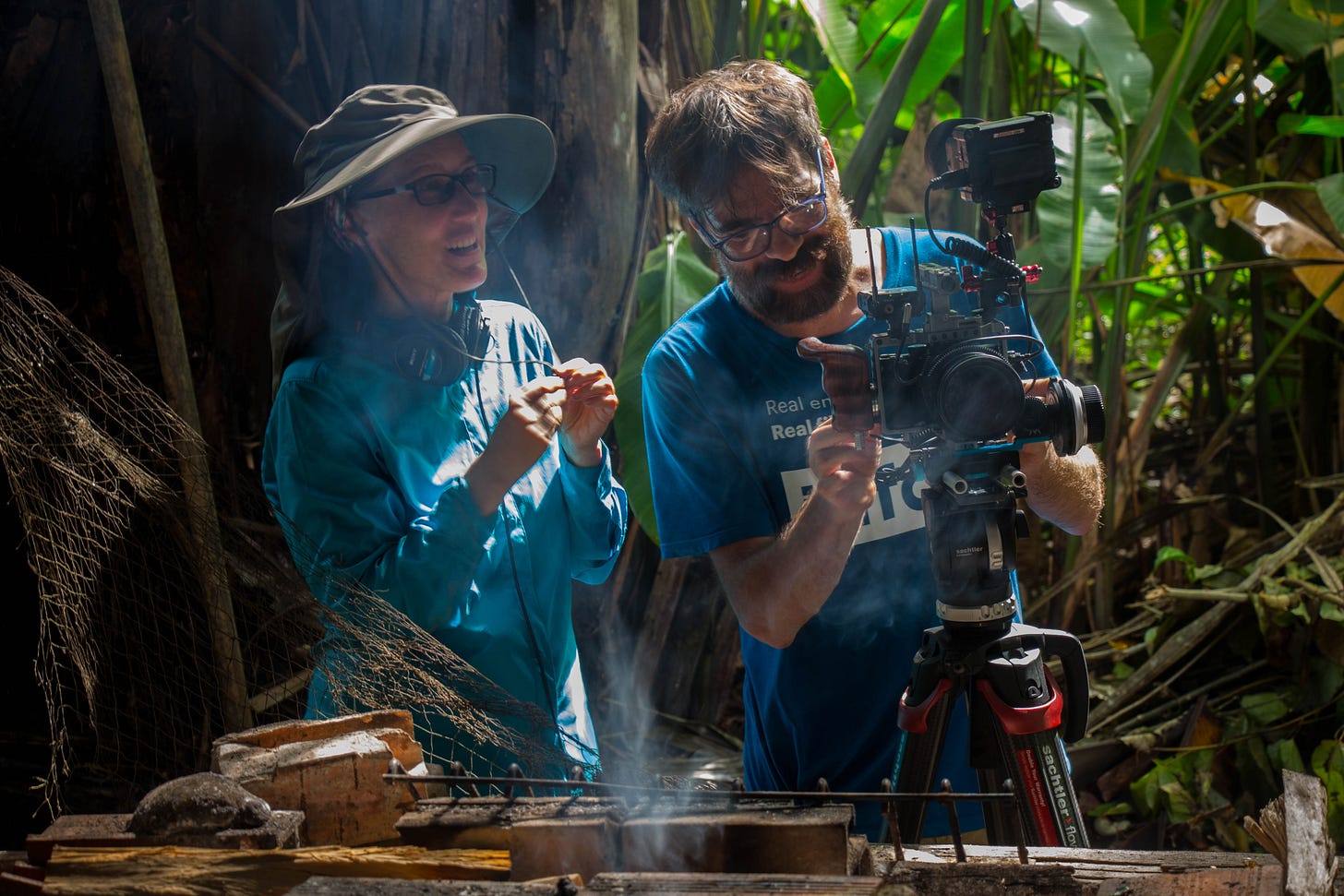It all began 10 years ago, in 2014, when Leonardo Tello, a Kukama Indigenous journalist, asked my partner Miguel and I to make a movie about the vibrant spirit world beneath his river in Peru’s northern Amazon. Leo’s children were growing up with Disney cartoons and Peppa Pig. Despite having a fondness for George (Peppa’s younger brother, for those unfamiliar), he wanted to show his kids animations of their own people’s stories.
Leo captivated us with tales about a parallel universe beneath the Amazon’s waterways ruled by the Karuara, which means people of the river in the Kukama language. These magical creatures wear crayfish hats, play poker with sardines and sleep in boa constrictor hammocks, but they’re far from silly. The Karuara have healing powers and maintain water levels in the Amazon’s lakes and rivers. When humans misbehave, these fearsome spirits rip apart the river banks with their claws, plunging fields and sometimes houses into the rushing water below.
A meeting of Karuara shamans from one of the film’s animations
We agreed to make the film on the condition that Leonardo come onboard as co-producer and script writer. Later he was joined by Mariluz Canaquiri, the film’s protagonist and leader of the Kukama Indigenous Women’s Federation, as well as a team of Indigenous artists, journalists and consultants. It was important to have Kukama advisors in key creative positions. This is special in Latin America where most films are made about Indigenous communities, rather than by and with them.
All the film’s animations were hand-painted. Some of the team with the Kukama god’s forehead, modeled on Don Jose, the Indigenous teacher who narrated the story.
Since those early days we’ve had some unexpected adventures: sleeping in a hammock in a wooden canoe and waking up with an alligator roasting on a fire under my bum, floating for hours in a whirlpool while filming the ‘doorway’ to the spirit village below, learning how to kill chiggers, tiny mites that like to burrow into dark and moist places, being rescued by Mariluz from two poisonous snakes copulating on a forest path, and assisting at our goddaughter’s birth in a small community with no running water or medical facilities.
Along the way the project grew to become much more than the film production. We co-published a book of Kukama legends illustrated by children with Leonardo’s radio station and the Kukama Women’s Federation. This bilingual book is being used to teach the endangered Kukama language in schools. Our team also trained Cuzqueño and Indigenous artists how to make animations, helped Mariluz and her women’s federation file 4 lawsuits to protect their river and provided training and equipment to journalists at the radio station. Now they’re making their own short films and music videos.
We distributed 1,400 copies of the Karuara book to schools in the Amazon region
And yes, we finished the film! Karuara, People of the River premiered at Toronto’s prestigious Hot Docs Film Festival this April, with Mariluz, Miguel and I in attending as proud co-parents. We had two sold-out screenings with warm, positive responses from the public. The film will have its Latin American premiere at the 28th Lima Film Festival PUCP this week, with 3 screenings and a red carpet presentation on Friday the 16th. (I’ll let you know how this goes in the next post).
(L-R Miguel, Translator, Mariluz and I speaking to the public after the screening)
We’ve also started grassroots screenings and held two free events while visiting Toronto this spring: one hosted by Cuso International, a long-time supporter, and the other at Centennial College in Scarborough. These venues provided welcoming spaces and time for thoughtful discussions with the public afterward, and both hosts provided spectacular (and free!) food buffets. Besides the fact that I love eating, the receptions also gave us an opportunity to speak informally with the audience members. Cuso even provided Miguel and Mariluz with a translator (a real human being) and headsets so they could mix with the crowd and talk to people.
Don Jose performs a ritual to help his grandson become a fisherman in the film
Even the critics have been kind. Marc Glassman, a renowned Canadian film reviewer, gave Karuara a glowing review in Classical FM. He writes, “this unique film extols the cosmology of the river, which is a living part of the local Indigenous society, through storytelling and glorious animation evoking the fantastic creatures that live beneath the water.”
“A brilliant mixture of legend and fact, combining animation and documentary, Karuara, People of the River comes together when a group of women start a legal fight to make the river a living entity, which should be protected from the pollutants used by industry.”
Respected journalist Richard Swift, writing in the New Internationalist magazine, said the film is “a tour de force, combining rich animation with interviews and the sheer physical beauty and sense of being in the home place of the Karuara.”
Although the film is done, we’re still on the job, holding screenings and working with our partners in the Amazon. Miguel and Leonardo are making podcasts about the devastating legacy of the rubber trade, as well as some lighter episodes with bird calls and I’m accompanying Mariluz’s federation in their legal battles to protect their river.
This past March the women won a lawsuit to recognize their river as a legal person. It was the first time a Peruvian court has acknowledged the rights of nature and even the conservative business press covered the case. (One notorious reporter accused our legal team of being “more hallucinogenic than LSD mixed with Ayahuasca”, but at least we’re not being ignored.) The lawsuit also calls on Petroperu, the government-owned oil company, to repair its leaky northern pipeline and conduct regular maintenance.
Women’s federation members and supporters march to a public hearing on the lawsuit.
The government appealed the ruling and another hearing was held in May. We’re still waiting for the final sentence but just received some good news: Peru’s Constitutional Tribunal, the country’s highest court, has found Petroperu guilty of a devastating spill on the Marañón River in 2014, and ordered that they repair the pipeline. This sets an important legal precedent for the women’s case.
Now that I don’t have to organize film shoots and hold microphones above people’s heads, I have more time for writing and hope you’ll sign-up to receive this free blog. Every few weeks I’ll share excerpts of a book-in-progress about our time on the river, updates on the lawsuits and fun news from our film screenings.
Thanks to everyone for their support during the past decade. It’s been fun keying in all your email addresses for this blog and seeing how so many people and organizations from around the world have come together to make this project happen. One world, one river.
Utsurpaki (Thanks, in Kukama)
Stephanie Boyd, co-director, Karuara, People of the River Asociación Quisca
Miguel and I during a film shoot in the community of Parinari, 2022











